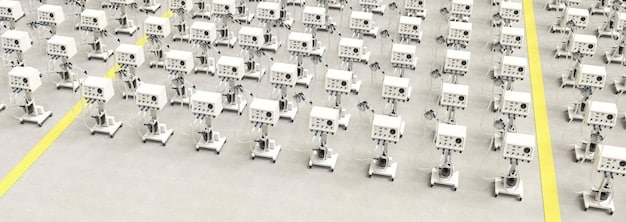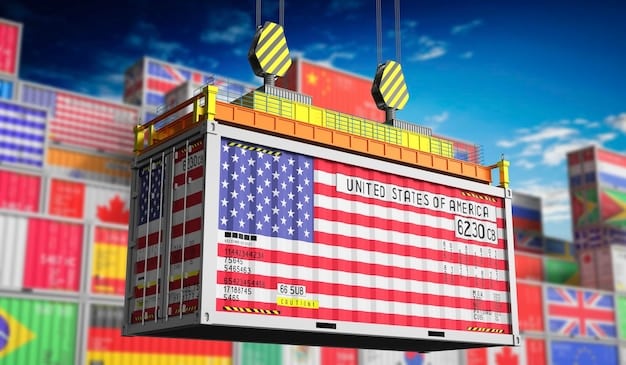Trade Deficit Impact: Analyzing the $70 Billion Figure on US Manufacturing

A recent Trade Deficit Update reveals a $70 billion deficit, prompting analysis of its impact on US manufacturing, potentially affecting job creation, economic growth, and international trade relations.
The recent Trade Deficit Update: Analyzing the Impact of the Current $70 Billion Deficit on US Manufacturing has raised concerns across various economic sectors. Understanding its implications is crucial for businesses, policymakers, and the general public alike.
Understanding the US Trade Deficit: An Overview
The trade deficit represents the difference between a country’s imports and exports. When a country imports more goods and services than it exports, it runs a trade deficit. Understanding the dynamics of this deficit is essential for grasping its potential impact on the US manufacturing sector.
What Constitutes the Trade Deficit?
The trade deficit is calculated by subtracting the total value of a country’s exports from the total value of its imports. A negative value indicates a trade deficit, while a positive value represents a trade surplus.
Several factors contribute to the trade deficit, including consumer demand, exchange rates, and global economic conditions.
- Consumer Demand: High consumer demand for imported goods can increase the trade deficit.
- Exchange Rates: A strong domestic currency can make exports more expensive and imports cheaper, widening the deficit.
- Global Economic Conditions: Economic downturns in trading partner countries can reduce demand for US exports.
Understanding these factors is crucial for assessing the trade deficit’s impact on US manufacturing.
In summary, the trade deficit is a key economic indicator influenced by various factors, and its fluctuations can have significant consequences for the manufacturing sector and the overall economy.
The Current $70 Billion Trade Deficit: Key Drivers
The recent Trade Deficit Update has shown a significant figure of $70 billion. Several factors have contributed to this deficit, necessitating a closer look at the economic landscape.
Factors Contributing to the $70 Billion Deficit
Various factors have influenced the current trade deficit. Analyzing these drivers is essential for understanding the underlying economic dynamics.
Increased consumer spending, global supply chain disruptions, and changes in trade policies are among the key drivers.
- Increased Consumer Spending: Higher consumer demand for goods, particularly imported products, has contributed to the deficit.
- Global Supply Chain Disruptions: Disruptions caused by geopolitical events and the pandemic have affected production and trade flows.
- Changes in Trade Policies: New tariffs and trade agreements can impact the balance of imports and exports.
These factors interact in complex ways to shape the trade deficit.

In short, increased consumer spending, supply chain issues, and policy changes are major drivers of the current $70 billion trade deficit.
Impact on US Manufacturing: Immediate Effects
The $70 billion trade deficit has immediate effects on the US manufacturing sector, influencing production levels, employment, and investment decisions. These effects highlight the challenges and opportunities faced by manufacturers in the current economic climate.
How the Trade Deficit Affects Manufacturing Output
The trade deficit impacts the manufacturing sector by altering the demand for domestically produced goods. Understanding these effects is key to navigating the economic landscape.
A high trade deficit can lead to reduced manufacturing output, job losses, and decreased investment in the sector.
Manufacturers may face increased competition from cheaper imports, leading to lower production volumes and reduced profitability.
- Reduced Production: Decreased demand for domestic goods can lead to lower production levels.
- Job Losses: Manufacturers may need to reduce their workforce in response to declining output.
- Decreased Investment: Companies may be hesitant to invest in new facilities and equipment amid economic uncertainty.
Manufacturers must adapt to these challenges to remain competitive.
To summarize, the trade deficit can have immediate adverse effects on US manufacturing, including reduced output, job losses, and decreased investment.
Long-Term Implications for Manufacturing Sustainability
Beyond the immediate effects, the persistent $70 billion trade deficit has long-term implications for the sustainability of the US manufacturing sector. These implications can affect innovation, global competitiveness, and economic resilience.
The Future of Manufacturing in a Deficit-Driven Economy
The long-term effects of the trade deficit on manufacturing sustainability are significant, potentially altering the sector’s trajectory.
Continued trade deficits can lead to a decline in manufacturing capabilities, reduced innovation, and increased reliance on foreign production.
Manufacturers may need to implement strategies to enhance productivity, reduce costs, and develop new products to remain competitive.

- Declining Capabilities: Reduced manufacturing activity can lead to a loss of specialized skills and expertise.
- Reduced Innovation: Companies may cut back on research and development spending due to financial constraints.
- Increased Reliance: The US may become more dependent on foreign sources for critical goods and materials.
Addressing these challenges is essential for the long-term health of the manufacturing sector.
Ultimately, the trade deficit’s long-term implications for manufacturing sustainability highlight the need for proactive strategies to support domestic production and innovation.
Policy Responses and Potential Solutions
Addressing the $70 billion trade deficit requires a multi-faceted approach involving targeted policy responses. These responses can range from trade negotiations to investments in domestic manufacturing capabilities.
Government Strategies to Counter the Trade Deficit
Various government strategies can be employed to mitigate the impact of the trade deficit and support US manufacturing.
These strategies include trade negotiations, investment in infrastructure, and support for workforce development programs.
Implementing effective policies can help to level the playing field for US manufacturers and promote sustainable economic growth.
- Trade Negotiations: Pursuing fair trade agreements that reduce barriers to US exports.
- Infrastructure Investment: Upgrading transportation and logistics infrastructure to improve efficiency.
- Workforce Development: Investing in training programs to equip workers with in-demand skills.
The success of these strategies depends on careful planning and execution.
In conclusion, effective policy responses are crucial for addressing the trade deficit and supporting the long-term competitiveness of US manufacturing.
Strategies for Manufacturers to Adapt and Thrive
In the face of the $70 billion trade deficit, US manufacturers can adopt various strategies to adapt and thrive. These strategies focus on enhancing competitiveness, fostering innovation, and building resilience.
How Manufacturers Can Remain Competitive
Manufacturers can implement several strategies to maintain and enhance their competitiveness in a challenging economic environment.
These strategies include investing in automation, improving supply chain management, and developing niche products with high value-added.
Adopting these strategies can help manufacturers to stay ahead of the competition and secure their future.
- Automation: Implementing advanced manufacturing technologies to improve efficiency and reduce costs.
- Supply Chain Management: Optimizing supply chains to minimize disruptions and reduce lead times.
- Niche Products: Focusing on specialized products that command higher prices and offer greater profit margins.
Adaptability is key to success in today’s global economy.
In summary, US manufacturers can adopt proactive strategies to adapt to the trade deficit, enhance their competitiveness, and thrive in the long term.
| Key Point | Brief Description |
|---|---|
| 📉 Trade Deficit | Difference between imports and exports, currently at $70 billion. |
| 🏭 Manufacturing Impact | Affects production, jobs, and investment in the US manufacturing sector. |
| 💡 Policy Responses | Trade negotiations, infrastructure investments, and workforce development. |
| 🤖 Adapt Strategies | Manufacturers can use automation, improve supply chains, and create niche products. |
Frequently Asked Questions
▼
A trade deficit occurs when a country’s imports exceed its exports over a specific period. This indicates that the country is buying more goods and services from other nations than it is selling.
▼
Trade deficits can arise from factors such as increased consumer demand for imported goods, a strong domestic currency making exports more expensive, and global economic conditions that affect trade flows.
▼
A trade deficit can lead to negative impacts on US manufacturing, including reduced production levels, job losses, and decreased investment in the manufacturing sector due to increased competition from imports.
▼
Policies to address the trade deficit include trade negotiations to reduce barriers to US exports, investments in infrastructure to improve efficiency, and workforce development programs to enhance manufacturing skills.
▼
Manufacturers can adapt by investing in automation to improve efficiency, streamlining supply chain management to reduce costs, and focusing on niche products with higher value to stay competitive in the market.
Conclusion
In conclusion, the trade deficit presents both challenges and opportunities for the US manufacturing sector. By understanding its drivers, mitigating its negative impacts through strategic policies, and embracing innovative strategies, manufacturers can navigate the economic landscape and achieve sustainable growth.